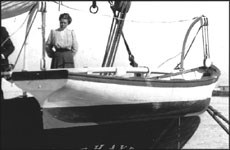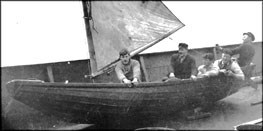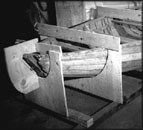|
By Stephen Canright 
NPS photo The Fort Ross Yawl The little Fort Ross yawl was built by George Kneass of San Francisco in about 1900 for use at the Call Ranch Landing at Fort Ross. The Calls ran cattle and sheep and cut redwood for shingles, ties, and fence posts. Perched on the bluffs above the Pacific, the ranch offered little in the way of a harbor, but there was a reasonable site for a chute, and later a highwire rig, that could drop cargo down onto the deck of a schooner or a steam schooner. The little yawl was a general purpose kind of boat, helpful in running lines for visiting schooners or for getting out to the Call's own vessels if they were moored offshore.The yawl was kept ashore, and dropped in from the highwire when it was needed. Fort Ross had no landing for even so small a boat. 
NPS photo The Fort Ross yawl at Hyde Street Pier. Yawl boats, by the middle of the nineteenth century, were generally used as ships' boats for schooners. The term is derived from the Dutch, and shares its origins with the British "jolly boat," a lapstrake ship's boat for small cargo vessels, of the same general shape. (There is no particularly logical link with the sailing rig of the same name.) The Fort Ross yawl is carvel-built, with a near-plumb stempost and wide wineglass transom stern with minimal rake. She is of medium scantlings; heavy enough to take a beating, yet light enough to row well. She has two thwarts, two rowing stations, and a generous sternsheets of redwood plank. The boat is framed in white oak and planked in Port Orford cedar, and is iron nail fastened. She is 13' in length overall and 5' 2" in beam; a length to beam ration of about 2.5 to 1.She is, in other words, a chunky little thing, but so nicely shaped that she would not be a chore to pull. She would certainly carry a load. There is nothing fancy about her. Her iron fastenings speak to her lack of pretension, but her lines and the neatness of her build insist on her pedigree. 
NPS photo The C. A. Thayer's yawl boat. This photo was snapped at San Pedro in 1905. The Joe Leathers Yawl The Joe Leathers yawl was collected at Tomales Bay in the late 1980s with the brand of its builder, Joe Leathers, burned into the starboard side of the transom. Leathers and his brother Richard operated a boat shop at Astoria, Oregon, between 1881 and 1903, so the yawl's time and place of origin are fairly well pinned down. What, we might ask, was an Oregon boat doing on Tomales Bay? My theory is that this boat is a yawl from a big schooner, perhaps the four-master Polaris, which was built in Oregon (at Marshfield in 1902) and wrecked on Duxbury Reef in 1914, near Point Bolinas, some fifteen miles south of Point Reyes. Because the schooner was driven onto the reef by a ninety-mile-an-hour southerly gale, one of her boats could easily have been recovered adrift or on the beach in the Point Reyes area and ended up at Tomales Bay. 
NPS photo The stern of the Joe Leathers yawl. Certainly, the Joe Leathers yawl looks like a cargo schooner yawl. At 16' 2" in length by 4' 10" of beam, she is a bigger boat than the Fort Ross yawl, but of similar overall design. She shares the carvel-planked hull, fastened with iron nails to steam-bent white oak frames. Her transom and backbone are also of white oak. Her stem post is raked slightly forward, but the wide wineglass transom is similar to the Kneass-built boat. Assuming that she is a ship's boat, her size would indicate that she was carried aboard something larger than a two-masted doghole schooner. While perhaps not heavy enough to be the principle boat of a large four-master, the Joe Leathers yawl could well have been the Master's boat on such a schooner. Evidence in the yawl of a two-masted sailing rig would seem to support this idea. There are mast partner holes through two of the thwarts; a larger main mast forward and a mizzen aft, probably for a lugsail ketch rig. The partners and steps, if they are not original to the boat, are at least very old. A boat designed for the Master's use might well be a bit lighter and have a more developed sailing rig than a general-purpose boat. Normally a yawl, if it were rigged at all, would have a single mast forward for a sprit or a lug rig. 
NPS Photo A pilot yawl comes alongside a steam schooner of San Francisco, CA, about 1900. The Blue Pilot Yawl The blue pilot yawl is, I think, one of the most evocative boats in the collection. Reputedly built around 1890, this lovely plumb-stemmed carvel yawl belonged to the San Francisco Bar Pilots, and did duty on the pilot station, some ten miles outside the Golden Gate, transferring pilots between the pilot schooner and vessels entering or leaving San Francisco. We have three pilot yawls in the Small Craft collection, but this one, with its gaudy blue interior, is clearly in the most original condition. It is pristinely fastened with copper rivets and nails, and its oak sheer strake and rub rail are apparently as they were built. Her sternsheets and hanging knees retain their original graceful curves. 
NPS Photo The blue pilot yawl at Hyde Street Pier. The pilot yawl used on the San Francisco Bar was essentially identical to East Coast boats developed in Boston and New York. Piloting at San Francisco started out in Boston-built schooners, and in general followed the Boston patterns of gear and operation. Although the yawls came to be built locally, by George Kneass among others, the design was largely unmodified. The clearest mark of the pilot yawl was the rounded skeg, the after end of the keel arcing up to tuck in just below the transom. This was done to prevent damage when the boats were thrown into the water from the deck of the pilot schooner, or when they were recovered with a whip from the foremast. 
NPS Photo A Norweigan pram on the deck of the Alaska Packer's tender, Kvicak, 1915. The gang is apparently playing around. The Norwegian Pram A boat like the Norwegian pram can provide a reflection of the cultural mix in the maritime history on the West Coast. We know, in theory, that the coasting trade of the Pacific Coast from at least the 1870s until its end in the late 1930s was entirely dominated by Scandinavian seamen. Almost all of the names of all of the officers and crews of the lumber fleet, under both sail and steam, were Scandinavian. The steam schooners were called "The Russian-Finn Navy." Yet very little remains in the way of identifiable cultural objects to mark the commanding Scandinavian presence on the West Coast. In general, the coasting vessels they sailed were of American design, their gear an d clothing not notably different from that of any seamen. Virtually nothing remains that can be pointed to as uniquely Scandinavian. Even the Scandinavian seamen's bars which used to dot the Mission District are now largely gone. But we do have this little pram, an unmistakable artifact of Norse culture transplanted to the West Coast. 
NPS Photo The park's Norweigan pram. The plywood molds help hold the weakened hull in shape. The boat is 18' 10" in length and 5' 3" in beam, and is lapstrake-planked in broad cedar planks, fastened with copper rivets in the Scandinavian manner. The stern is a fairly broad round-bottomed transom of oak. The bow is a small transom only about 8" wide, raking sharply forward, and carried high by a marked rise in the forward sheer. A plank keel is notched into the bottom of each transom, and is rockered up forward to meet the transom. The forward transom is so small and so high that the effect is almost of a sharp bow. The framing and backbone are of oak, and four thwarts are fitted, with three rowing stations. There is no evidence of a sailing rig. The connection of the hood-ends of the planking is unusual: square-section copper rivets are driven diagonally through the beveled edges of the transoms and are riveted with roves on the inner face of the transom. It's a crude-looking mechanism, but seemingly effective. The finish is somewhat crude overall, suggesting that it was more likely built in a company yard than in an established boat shop. 
NPS Photo A tule splitter in use in the Sacramento Delta. The Tule Splitter The Tule Splitter, a little flat-bottomed double-ender designed for duck hunting among the tule reeds of the lower Sacramento River Delta, is about as simple as a boat can be. It has only a single bottom board and a two single plank sides. The remarkable thing about the boat is the width and quality of these three redwood planks. The bottom plank is a full 24 1/2" wide and 13' long, and the side planks are 1/2" by about 18" wide - all old-growth, tight-grained lumber. With planks like this, the effect is almost like building in plywood, and the construction of a boat can be very simple. We found this example in about 1990, sitting desolately on a levee top in Collinsville, a river fishing town in Solano County. Collinsville is almost a ghost town now, its few houses occupied by the older generation of the old Italian commercial fishing families whose livelihood was cut off in 1957 when the river salmon fishery was shut down. The tule splitter belonged to the Vitalie family. We talked to Frank Vitalie, who had built it sometime around 1920 and used it for hunting around the sloughs and islands of the Lower Sacramento Delta. Frank was pleased that we saw the importance of the boat and agreed to donate it to the Park. The main reason we were able to spot the tule splitter among the levee weeds was a description written by J. Porter Shaw, the Oakland lawyer and boat aficionado for whom the Park's library is named. Shaw was especially fond of the tule splitters, having built and used them as a young man. He notes wistfully that he still has his old sculling oar, an especially fine and flexible one, "...like a piece of whalebone," which he has not used for thirty years. Shaw describes hours of lying on his side in the bottom of the boat, sometimes sculling 18 or 20 miles a day. Sculling silently along Shaw was able to approach within feet of a feeding duck before the bird took flight. The shotguns lay at hand, resting in notches cut in beams which crossed the boat at sheer level. At the end of the day, Shaw was so stiff from lying on his side that he could barely get out of the boat. 
NPS Photo The Collinsville tule splitter as found. The wide bottom board is about an inch thick, and is rockered by about two inches. The ends of the bottom are sharply pointed at each end, and the side planks rap around the bottom and are edge-nailed to it, without any chine timber. Stem and stern posts are simple triangular-section blocks, raked sharply fore and aft, with the hood ends of the side planks nailed from either side. The side planks flare somewhat amidships, giving the boat a beam of 2' 10", flaring from the 24 1/2' bottom plank. A forward and after beam are nailed in at sheer level and three floor timbers, about 2" x 3", cross the bottom. Rudimentary top frames of 1" x 5" plank are nailed to the side planks, but do not connect with the floor timbers. All nails are galvanized iron. The effect is a rough but practical one-man boat, with very sharp ends, and the limited stability of a canoe. The boat is in the tradition of the Cajun Pirogue, but in this form is apparently unique to the Sacramento Delta. Shaw notes that in addition to the sculling oar, regular sweep oars were sometimes fitted in rowlocks on outriggers made from barn hinges, so that good distances could be covered rowing in the manner of a shell. Our boat shows no evidence of rowlocks ever having been fitted. In competent hands, on the relatively sheltered waters of the lower Delta, the tule splitter would be a sweet little boat for poking through the reed banks. 
NPS Photo A power dory on the cod grounds. Captain John Shields of the schooner Sophia Christenson is in the bow. The Power Cod Fishing Dory The cod fishing dory is one of the most seaworthy small boats ever developed. A very simply constructed boat, the dory has a flat bottom with straight flaring sides, a sharp raking bow, and a narrow V-shaped transom. While initially somewhat tender due to the relatively narrow bottom, dories gain stability as they are loaded down and with a moderate load of fish and gear, there is no better sea boat for its size. The schooner C.A. Thayer ended her commercial career as a cod fisherman, making yearly trips to the rich cod banks in the Bering Sea, north of the Aleutian Island chain. Even in the summer, this is a hard and dangerous part of the ocean, cold and foggy, with heavy seas and winds always ready to trap the unwary. Fishing was still done in the traditional manner developed on the Grand Banks of the Atlantic Coast, hand-lining from dories, each boat with a lone fisherman venturing out from the schooner mother ship each day, with luck to return with a boat full of cod. 
NPS Photo The park's dory. Dories were traditionally fitted with a single pair of oars and a simple spritsail sailing rig. By the middle of the nineteenth century dories were being produced as standardized stock boats by specialized shops in Massachusetts and Nova Scotia. On the East Coast, the dories worked under oars and sail until they were superseded by motor trawlers in the 1930s and 40s.The power dory, as it had developed by the end of the 1920s, was a very efficient little boat, able to carry as much as two tons of fish, at good speed, with reasonable safety. |
Last updated: February 28, 2015
